Exploring the World of Virtual Reality Headsets
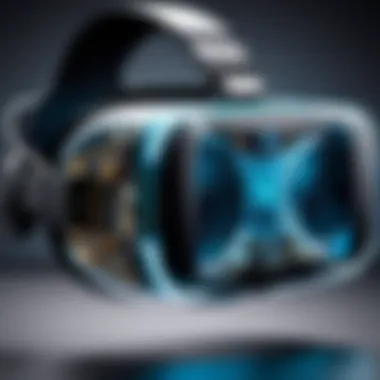
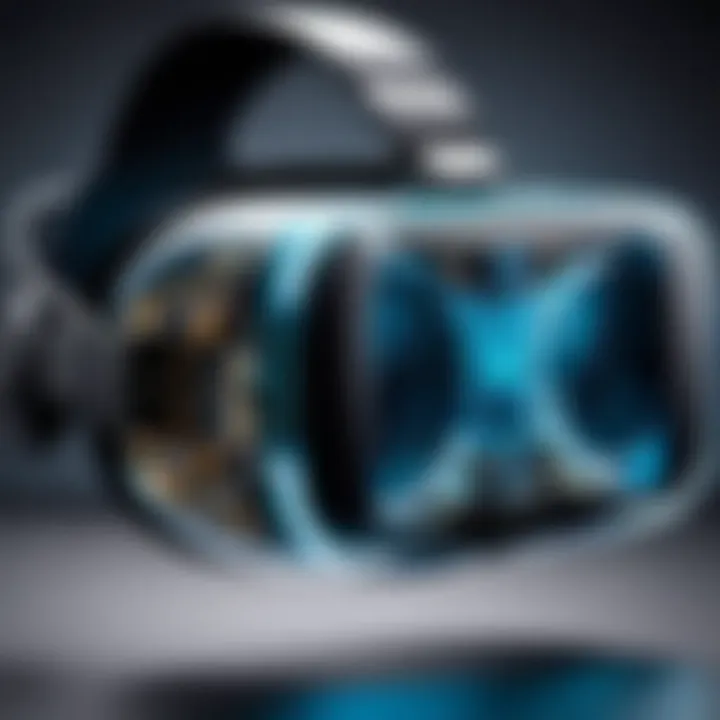
Intro
In recent years, virtual reality (VR) has emerged from the realms of science fiction into a burgeoning industry, captivating a vast number of users and reshaping how we interact with technology. From gaming aficionados to education experts, everyone seems to be curious about the power and reach of virtual reality headsets. As we step into the era of immersive experiences, understanding the intricacies of these devices becomes not just beneficial but essential.
This exploration aims to bring to light the significance of virtual reality headsets. These devices, housed with a blend of intricate technology and creative design, offer experiences that extend beyond traditional media. They are not only changing gaming dynamics but are infiltrating education, workplace training, and even therapy settings.
What’s fascinating is how these head-mounted displays work. They don't merely provide visual entertainment; they transform our perception of reality. Imagine a classroom where students can experience Ancient Rome firsthand or a corporate training session where users can simulate high-pressure scenarios without any real-life consequences. That's the magic of VR.
This guide will dissect the various components that make up virtual reality headsets, delve into their applications in diverse fields, and examine the benefits and challenges facing this innovative technology. Readers can expect to gain insights into market trends, user experiences, and what future developments may hold for VR.
Let’s embark on this journey to demystify virtual reality headsets and uncover the layers of technology that drive their adoption across numerous sectors.
Understanding Headset Technologies
Virtual reality headsets come with a variety of technologies that reflect on their capabilities and usage. At their core, these devices utilize advanced optics and sensors to create lifelike, immersive experiences. Understanding these technologies is crucial for appreciating the full capabilities of VR headsets.
Key Components of VR Headsets
- Display: Most headsets use OLED or LCD displays. OLED tends to offer deeper blacks, while LCD provides a more natural color balance.
- Field of View (FOV): The degree of peripheral vision provided by the headset isn’t just a measurement; it affects immersion levels. A wider FOV generally leads to a more convincing experience.
- Tracking Sensors: These can be either outside-in or inside-out. Outside-in tracking relies on external sensors to gauge the headset's position, while inside-out tracking utilizes onboard cameras for positional awareness.
The effectiveness of a VR headset often hinges on its ability to create a natural interaction between the user and the environment, an aspect that is intensely reliant on these technologies.
To achieve seamless interaction and realistic experiences, manufacturers are continuously innovating. Advances in motion controls, eye tracking, and enhanced audio systems contribute significantly to the burgeoning appeal of these headsets.
Applications of Virtual Reality
The impact of virtual reality on various sectors cannot be understated. Here’s how VR is carving its niche in diverse fields:
- Entertainment: The gaming industry has been an early adopter of VR technology. Titles like Half-Life: Alyx are pushing the envelope of what gaming can achieve.
- Education: Programs enable students to engage in immersive learning experiences. Platforms like Engage provide virtual classrooms where learners can interact in real-time.
- Healthcare: VR is gaining traction in therapeutic settings, helping patients confront fears or practice cognitive skills in a controlled environment.
- Training and Simulation: Industries like aviation and military training utilize VR for simulation purposes, providing a safe space to develop skills without real-world consequences.
Challenges and Considerations
Despite the promise of virtual reality, it is not devoid of challenges:
- Cost: High-quality headsets can be a steep investment.
- Accessibility: Not everyone has access to the necessary technology or space to utilize VR effectively.
- Health Concerns: Prolonged use can lead to issues ranging from motion sickness to eye strain.
Understanding these aspects is vital for informed choices around VR technologies. As the industry adopts new standards and improves on existing technologies, it's become clear that the journey to fully harness the potential of virtual reality devices is just beginning.
Preamble to Virtual Reality Headsets
Virtual reality headsets are not just a mere novelty; they represent a significant leap forward in how we interact with digital content. As technology advances, these devices are becoming more integral in various fields. Whether one is gaming, exploring a virtual museum, or conducting simulations for training purposes, understanding the fundamentals of VR headsets is essential. This section aims to lay the groundwork, covering what they are, their evolution, and the reasons they matter today.
Defining Virtual Reality Headsets
At their core, virtual reality headsets are devices designed to simulate a user’s physical presence in a virtual environment. They allow users to immerse themselves in a digitally-created cosmos that feels real, tricking the brain into perceiving these fabricated spaces as tangible. A headset typically includes a screen for each eye and often integrates audio and motion sensors to create a comprehensive experience.
The effectiveness of these devices lies in their ability to transport users away from their immediate surroundings into another world. While talking about their features, many focus on the high-definition displays or the impressive audio systems, but the real magic happens with the seamless integration of these components that contribute to a coherent sense of place.
The appeal of virtual reality headsets goes beyond gaming but encompasses educational tools and therapeutic functions as well. Educators are tapping into VR to deliver immersive lessons, while health professionals use these technologies to help patients with phobias or pain management. The modern VR headset is a versatile tool, opening doors to new possibilities we previously deemed unimaginable.
History of Virtual Reality Technology
The timeline of virtual reality technology is a fascinating exploration of human ingenuity. It stretches back to the 1960s when the first instances of VR emerged, though it took decades of advancements for the technology to mature. In the early days, devices like the Sensorama and the Ultimate Display proposed visions of virtual environments but seriously lacked the practical implementation we see today.
The late 80s saw a surge in interest with the creation of systems such as the Virtuality Group's arcade machines, which offered multiplayer experiences in a virtual space. However, this was just the tip of the iceberg as technology continued to evolve, albeit slowly. Key advancements in computational power and graphics in the 2000s finally paved the way for the development of consumer-ready VR devices.
Then came the Oculus Rift in 2012, igniting a revival of the VR industry. This new generation of headsets made the technology accessible and appealing to consumers, and since then, various companies like HTC with the Vive, and Sony with the PlayStation VR have fostered a vibrant landscape of immersive experience.
Today, virtual reality stands at a pivotal point, balancing on the cusp of everyday use and speculative futures. Understanding its journey helps appreciate the profound impact it can have moving forward.
"The future is already here—it's just not very evenly distributed." — William Gibson
As we delve deeper into the inner workings, applications, and future of virtual reality headsets, it’s crucial to grasp this historical context to fully realize the significance of such technology.
By examining these devices’ evolution, we can illustrate how they’ve transformed from rudimentary prototypes into sophisticated platforms that reshape experiences across numerous sectors.
How Virtual Reality Headsets Work
Understanding how virtual reality headsets function is essential to appreciating their role in today's technology landscape. These devices rely on a combination of hardware and software, each part contributing to the overall experience. Without grasping the mechanics behind them, one might underestimate their capabilities and the potential impact they have in diverse fields.
A solid comprehension of the intricacies of virtual reality headsets provides insights into their advantages along with any limitations. For instance, knowing how the hardware components like optics and sensors affect user immersion can enhance one’s expectations and interactions with virtual environments. Let's break down some critical elements that make these headsets tick.
Key Components of VR Headsets
Optics
Optics is a fundamental aspect of VR headsets, directly influencing the minimal visual distortion experienced during use. This element is designed to magnify the display screen so that it fills the user's field of vision. One of the key characteristics of optics is the lens type, commonly aspherical lenses, which help achieve a wider field of view while keeping images crisp. This is a beneficial design choice for rendering expansive virtual environments in a more natural manner.
However, there's a unique feature worth mentioning: the adjustable lens settings. They allow users to customize the fit for better clarity according to their eyesight. While this increases accessibility, it can also lead to minor challenges, like potential image distortion for those with particular vision prescriptions.
Displays
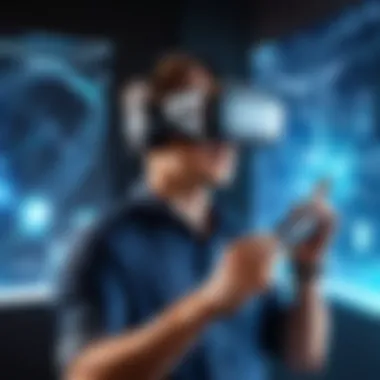
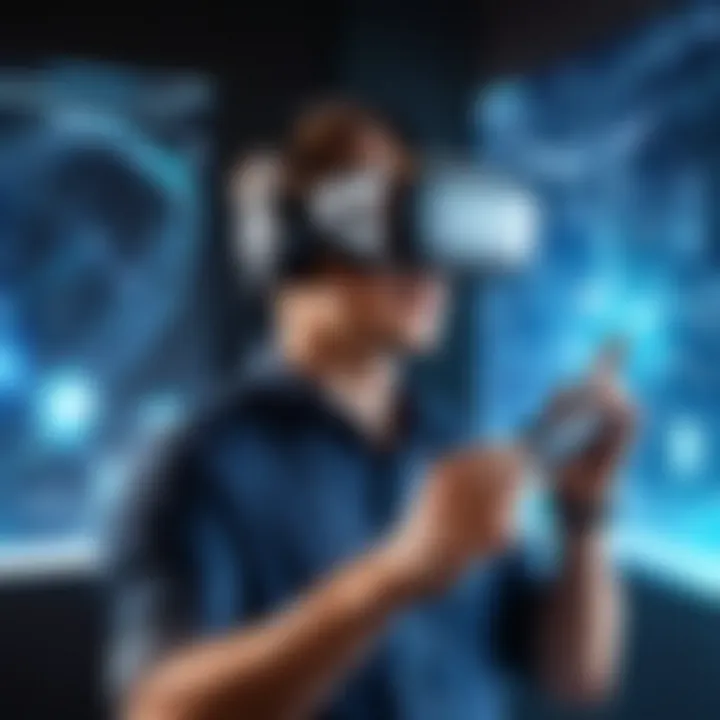
Displays serve as the primary medium through which users observe the virtual world. A common type used today is the OLED (Organic Light Emitting Diodes) display, known for its vibrant colors and deep blacks, thus providing an immersive experience. This standout characteristic makes OLED displays a popular choice among manufacturers looking to provide high-quality visuals.
A unique advantage of these displays is their low latency, ensuring a smoother experience with minimal lag between actions and responses. While they're widely praised, some drawbacks exist, such as the potential for burn-in over extended use, which might affect longevity for hardcore gamers or professionals who use VR for prolonged periods.
Audio Systems
Audio systems play an equally crucial role in creating a believable virtual journey. Spatial audio technology is at the forefront here, allowing users to perceive sounds coming from all directions, enhancing the feeling of presence within a virtual environment. A key trait of audio systems in VR headsets is their ability to synchronize with visual stimuli, fostering a sense of realistic immersion.
One unique feature of modern audio systems is the integration of noise-canceling technology, which helps to block out external distractions. While effective, this can occasionally create a disconnection from the real world, a factor that users should consider during longer sessions.
Tracking Sensors
Tracking sensors are what enable the headset to translate the user's movements into the virtual environment. These components are pivotal for augmented immersion. A critical aspect is their ability to provide 6 degrees of freedom (6DoF), allowing users to move freely in any direction. This characteristic is crucial, as limited tracking can severely dampen the interactive experience.
A standout feature of advanced tracking systems is inside-out tracking, which allows for precise user movement without needing external sensors. However, the downside might include occasional hiccups in tracking accuracy in dimly lit areas or when occluded by objects, which could lead to a less gratifying experience.
The Role of Software in VR
Software orchestrates the interactions within virtual reality environments, acting as the backbone of usability and experience. It's pivotal to understand how aspects such as operating systems, user interfaces, and content compatibility affect what users can do with their VR headsets.
Operating Systems
Operating systems customized for VR headsets govern the entire user experience. A well-designed operating system enhances performance and responsiveness, making it easier for users to transition between applications seamlessly. One appealing characteristic of these specialized operating systems is their ability to manage spatial tracking effectively, which is crucial for an enjoyable experience.
User-friendly interfaces often mark these systems. However, the challenge lies in developing an operating system that can handle extensive multitasking without lag or environmental disorientation.
User Interfaces
User interfaces are crafted to facilitate interaction within the virtual realm, providing a bridge between the user and the digital experiences they engage with. A key aspect is the intuitive design that makes navigation straightforward, minimizing the learning curve for new users. This is critical for all audiences, especially first-timers who could be overwhelmed by complex controls.
However, not all user interfaces are created equal. Some may prioritize aesthetics over functionality, which could lead to confusion. Striking the right balance is important for developers aiming to create an immersive yet usable environment.
Content Compatibility
Content compatibility determines what experiences and applications can be accessed through a VR headset. This aspect is essential to expanding the headset's capabilities, allowing users to enjoy games, educational tools, or simulation training. A notable characteristic is the ability to support various media types, including games and educational software.
However, a unique challenge this creates is the fragmentation in content availability. Not all platforms support all headsets, leading to a disjointed experience for users looking forward to exploring a wide array of applications. This hinders the universal appeal of certain VR devices.
"Understanding how each component of a VR headset contributes to the user experience is critical in harnessing the full potential of this groundbreaking technology."
Overall, the combined knowledge of hardware and software components forms a solid basis for appreciating the evolving capabilities of VR headsets. By grasping how these devices operate, users can make informed decisions about their applications and maximize the benefits they can derive from virtual reality experiences.
Applications of Virtual Reality Headsets
The realm of virtual reality headsets extends far beyond being just another gadget for gamers or tech enthusiasts. Their applications touch various sectors from entertainment to therapy, transforming how we perceive and interact with both the digital and real worlds. Understanding these applications provides invaluable insight into their significance and potential.
Entertainment
Gaming
In the realm of gaming, virtual reality has become a game-changer, quite literally. VR gaming engages players like never before, allowing them to step inside their favorite worlds and become part of the action. The key characteristic here is immersion. Imagine not just watching characters on a screen, but feeling as though you’re right there on the battlefield or wandering through a fantastical realm. This unparalleled level of engagement makes VR gaming incredibly popular.
One unique feature of VR gaming is the freedom of movement it offers. Unlike traditional gaming where players are static, VR gaming lets individuals physically move, further enhancing the experience. However, it’s not all smooth sailing. Some users report feelings of nausea or disorientation, a drawback that can deter new players. Despite this, the overall experience is often considered worthy of the learning curve.
Virtual Tours
Virtual tours are another standout application. They allow users to explore far-flung destinations or local landmarks from the comfort of their homes. This aspect not only democratizes access to information but also makes it far more engaging. The key characteristic of virtual tours is their ability to simulate real environments, thereby providing a sense of presence.
A unique feature of virtual tours is the interactivity they offer. Users can click on objects of interest or navigate through spaces at their own pace. The downside? Without a high-quality headset and good internet connection, the experience might not be as rich. Still, for educational institutions and travel agencies, they provide a remarkable tool for showcasing locations.
Movies and Experiences
When it comes to movies and experiences, VR opens a door to a whole new dimension of storytelling. Films can be crafted in ways that allow viewers to witness a story from multiple characters’ perspectives or even choose their paths. This aspect makes the viewing experience far more engaging and personal. Importantly, the key characteristic here is interactivity, which distinguishes it from traditional cinema.
One unique feature of VR movies is the potential for audience participation. Viewers may find themselves making choices that influence the narrative. However, producing high-quality VR films is a challenge, given the technology required. There’s a risk that the novelty might wear off for audiences if content doesn't evolve. Despite these challenges, the potential for immersive storytelling in this domain remains substantial.
Education and Training
Medical Training
Moving on to education and training, the applications of virtual reality are remarkably significant, especially in medical training. VR allows medical students to practice procedures in a risk-free environment. The key characteristic here is realism; simulations recreate real-life scenarios that practitioners might face.
The unique feature of medical training through VR is the ability to perform complex surgeries without real-life consequences. This can build confidence and proficiency before entering the operating room. Despite its advantages, there's still the concern about access to the necessary technology and resources in education, which can be a barrier for some institutions.
Military Simulations
Military simulations are another crucial area where virtual reality finds its footing. The military uses VR to conduct training exercises that mimic combat conditions, preparing soldiers for real-life scenarios. The key characteristic here is enhanced preparedness, ensuring that troops are trained effectively.
One unique aspect of military simulations is the ability for soldiers to experience a virtual battlefield repeatedly until they achieve desired responses. Nevertheless, the use of such technology necessitates a careful balance to prevent situations where soldiers become desensitized to real combat challenges.
Corporate Training
Corporate training programs also benefit immensely from VR. Using simulations, companies can train employees on various skills, from customer service scenarios to complex operational procedures. The key characteristic here is scalability, allowing companies to train multiple employees simultaneously in a controlled environment.

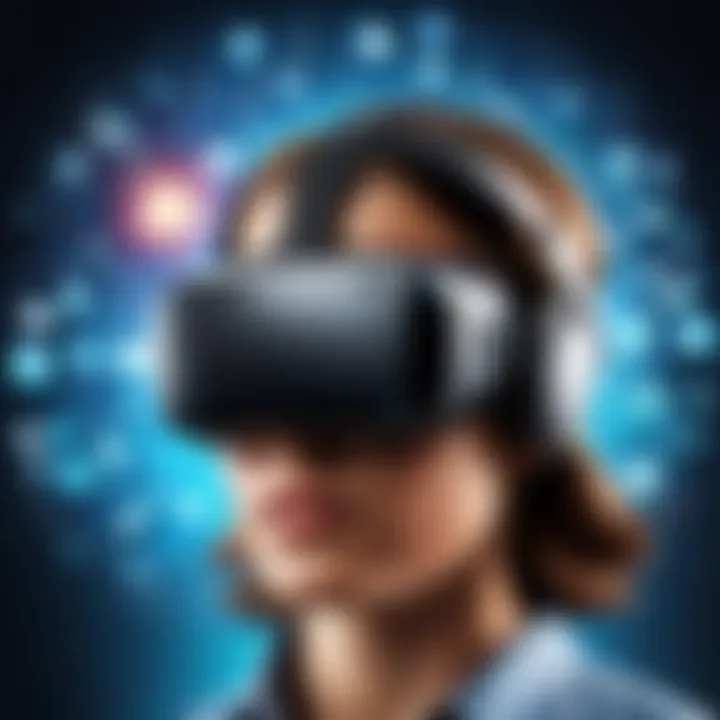
A unique feature of corporate training via VR is its adaptability. Training can be customized to suit different roles within a company. On the downside, the initial investment in VR technology and content can be steep, leading companies to hesitate before diving in.
Therapeutic Uses
Exposure Therapy
In therapeutic settings, virtual reality has become a powerful tool, especially in exposure therapy. This method helps individuals confront their fears in a controlled environment. The key characteristic of exposure therapy in VR is its ability to provide gradual exposure to fear-inducing stimuli, which can help reduce anxiety over time.
One unique advantage of using VR for this purpose is the controlled context. Therapists can adjust various parameters to suit the patient's needs. However, it’s critical to note that not every individual responds positively to VR therapy, so personalization remains key.
Pain Management
Interestingly, VR is also being explored for pain management. By immersing patients in a captivating virtual environment, they can distract themselves from pain during medical procedures. The key characteristic here is distraction, which can significantly alter a patient's perception of pain.
The unique feature that makes VR effective in pain management is the ability to transport patients to serene settings, such as beaches or forests. On the flip side, the effectiveness of VR therapy can vary greatly from one individual to another, necessitating further study.
Rehabilitation
Lastly, VR has found its niche in rehabilitation practices. Physical therapy can be more engaging when integrated with game-like elements that encourage movement and commitment. The key characteristic here is motivation; patients often feel more compelled to engage when they enjoy the process.
A distinctive feature of VR rehabilitation is its ability to gamify recovery, making tedious exercises feel less daunting. Still, there’s a hurdle to overcome—the dependence on technology and the potential for technical issues that could hinder progress. Nevertheless, the innovative prospects of VR in rehabilitation hold promise.
In summary, the application of virtual reality headsets spans industries and purpose, offering transformative opportunities. From gaming experiences that draw participants into dynamic worlds to training simulations that prepare individuals for real challenges, the implications are vast and varied.
Advantages of Using Virtual Reality Headsets
Virtual reality (VR) headsets have opened the door to a range of possibilities, impacting various sectors significantly. Aimed at immersing users in a digital world, these headsets provide unique benefits across different applications. Understanding the advantages of employing VR technology can help both individuals and organizations maximize its potential. From creating immersive experiences to enhancing learning and fostering innovative problem-solving, VR is transforming how we engage with digital content.
Immersive Experience
One of the most compelling advantages of virtual reality headsets is the immersive experience they offer. VR allows users to be transported into wholly different environments, making interactions feel remarkably real. Whether it's walking through the ancient ruins of Rome or exploring outer space, the sensation can be breathtaking.
This level of immersion is achieved through high-quality visuals and surround sound, combined with the freedom to interact using hand controllers. It’s not just about looking at a screen; it’s about feeling like you are part of the action. Users often report heightened emotional responses and greater engagement with the content.
"VR turns observation into involvement."
Enhanced immersion can be particularly crucial in training scenarios. Imagine a medical intern practicing a surgical procedure without needing a cadaver. The risks are minimized, yet the training remains authentic, which is invaluable in fields demanding precision.
Enhanced Learning
The world of education benefits immensely from implementing VR headsets. Traditional learning methods often struggle to capture students' attention in a meaningful way. In contrast, VR fosters an environment where complex concepts can be brought to life.
Take anatomy, for example. Instead of flipping through pages of a textbook, students can explore 3D models of the human body. They can visualize organs and systems interactively, enhancing comprehension. This hands-on approach aids retention and makes learning more enjoyable.
In addition, VR can break down geographical barriers. Students across the globe can participate in virtual field trips that would be logistically impossible in real life, making education more accessible and inclusive.
Innovative Problem Solving
Virtual reality is not just about entertainment or education; it also serves as a platform for innovative problem solving. Companies are beginning to use VR to simulate real-world scenarios to identify and analyze issues before they become critical. Designers, for instance, can prototype and test products in a virtual space, allowing for rapid iteration without the costs of physical manufacturing.
Moreover, in sectors like cybersecurity, VR can simulate potential security breaches. Professionals can visualize the threats in a controlled environment, fostering strategic thinking on proactive measures to combat cyber attacks.
This kind of visualization pushes boundaries, leading to unique insights that might not be attainable through conventional methods. Thus, VR headsets are becoming indispensable tools for professionals who rely on creativity and innovation.
In summary, the advantages of using virtual reality headsets stretch far and wide. They enhance immersive experiences, bolster educational efforts, and promote innovative solutions to complex problems. As technology continues to advance, these benefits will grow more pronounced, making VR an essential element in various fields.
Challenges and Limitations of Virtual Reality Headsets
In any discussion about virtual reality headsets, it’s essential to address the sticking points that can hinder their widespread adoption. Despite their potential to revolutionize how we interact with digital content, several challenges present hurdles for users and developers alike. Understanding these aspects provides a more nuanced perspective on the effectiveness and practicality of VR technologies, which is vital for IT professionals, cybersecurity experts, and students interested in the tech field.
Physical Discomfort
One of the most commonly faced challenges is the physical discomfort associated with prolonged use of VR headsets. Users often report various ailments, ranging from headaches and nausea to fatigue and eye strain. This discomfort usually results from a combination of factors, including the weight of the headset, the fit, and the visuals.
The phenomenon known as motion sickness occurs when the brain receives conflicting messages from the inner ear, eyes, and muscles. For instance, if a user is immersed in a gaming environment where they are moving around while sitting still, this dissonance can lead to dizziness and queasiness.
To alleviate these issues, manufacturers are investing in ergonomics and design improvements. Lighter materials, better weight distribution, and customizable fit options are becoming standard features. Furthermore, there’s ongoing research into reducing latency and enhancing frame rates to create a more seamless experience, minimizing discomfort.
To ensure a more comfortable experience, users should take regular breaks and keep track of their physical responses when using VR.
Cost Considerations
Cost remains a significant barrier for many potential VR users. High-quality headsets and the necessary accompanying technology, such as powerful computers or consoles, represent a considerable financial investment. Brands like Oculus and HTC Vive offer premium devices that can exceed several hundred dollars. As a result, access to VR experiences can feel out of reach for casual consumers and educational institutions alike.
The financial burden doesn't stop at the initial purchase. Maintaining and upgrading the hardware can also add up. Additionally, the cost of software and content to maximize the utility of VR headsets does not help alleviate concerns for budget-conscious users.
Vendors are now exploring subscription models and content bundles to allow users to experience VR without breaking the bank. Furthermore, as technology matures, prices are likely to drop, bringing these innovations to a wider audience.
Content Availability
Finally, content availability is a critical issue that hinders the growth of the VR market. While some applications and games thrive, the overall library is still relatively limited when compared to traditional gaming systems or media consumption platforms. Users often find themselves asking:
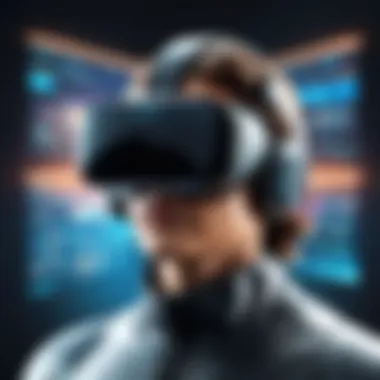
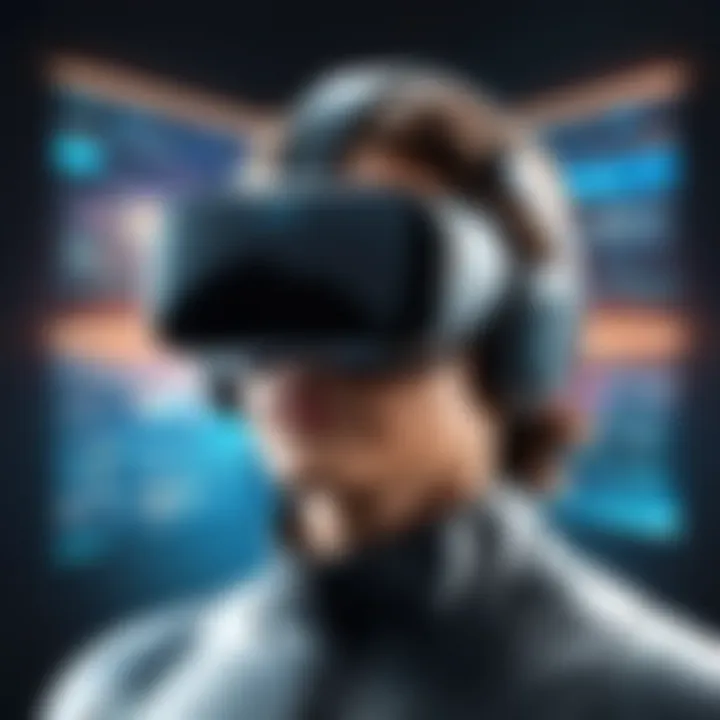
- What can I do in VR beyond gaming?
- Is there enough educational content available?
Although many developers are entering the space, creating high-quality VR content requires specialized skills and resources, which can slow the production rate. Additionally, issues of content compatibility across different platforms further complicate access for users.
To keep pace with a growing audience, developers must prioritize the creation of diverse VR experiences that cater to multiple interests, from health care training simulations to immersive storytelling in film or literature.
"Innovative content will dictate market survival; expand offerings or risk obscurity."
As we understand the challenges posed by physical discomfort, cost considerations, and uneven content availability, it becomes clear that these limitations are not just obstacles. They represent areas of opportunity for ongoing improvements and innovations that can further propel the adoption of VR technology.
Market Trends in Virtual Reality Headsets
The current landscape of virtual reality headsets is more dynamic than ever, with trends shaping how these devices are perceived and utilized across various sectors. Understanding market trends is crucial, for it sheds light on consumer behavior, innovation, and the overall growth trajectory of the virtual reality industry. As we navigate through suppliers, adoption rates, and forecasts, one finds that this information holds significant weight for IT professionals, cybersecurity experts, and students alike, who might be analyzing technology from various angles.
Consumer Adoption Rates
Consumer adoption rates serve as a bellwether for the health of the VR market. Statistical insights indicate a gradual increase in users venturing into virtual experiences. With reports showing that global sales of VR headsets rose by over 20% last year, it's evident that more consumers are becoming inclined toward integrating this technology into their lifestyles. Factors such as improved affordability, enhanced content availability, and more engaging user experiences are fueling this growth.
- The Oculus Quest 2 has played a starring role here, representing one of the most successful entries in the market due to its easy setup and user-friendly features.
- Valve’s Index offers an immersive experience, appealing particularly to hardcore gamers.
The upward trend reflects not only consumer interest but also a cultural shift where VR is increasingly viewed as a staple rather than a novelty.
Key Players in the Market
The VR market is an ecosystem dominated by several key players, each contributing distinct innovations that enrich the landscape. Facebook (Meta) stands out as a power player since acquiring Oculus, leading the charge with its focus on social VR experiences. Sony, with its PlayStation VR, has carved a niche by marrying VR with established gaming systems. Other noteworthy contenders are HTC, with its Vive series, and Pico, showing that the race is not solely reliant on American manufacturers.
- Meta Platforms
- Sony Interactive Entertainment
- HTC Corporation
- Pico Interactive
- Microsoft
- HP Inc.
These brands continuously compete, not just in terms of hardware but also in software development and partnerships that expand the reach and potential applications of VR.
Future Market Predictions
The future of VR headsets looks poised for a robust trajectory, with predictions suggesting that we may see the market expand at a compound annual growth rate (CAGR) of over 30% in the next five years. Several elements catalyzing this growth include:
- AI Integration: Enhancing user experience with smart recommendations.
- Cross-Platform Compatibility: Breaking down barriers between different systems and devices.
- 5G Technology: Offering low-latency streaming of high-quality VR content.
"The integration of AI and cloud technologies will likely transform how users interact with VR environments, making them more intuitive and realistic."
By 2025, we might even see mainstream adoption in business environments, dictating a change in how industries, like aerospace and automotive design, conduct simulations and training. Growth potential thus hinges on adaptability and consumer appetite for new technology, and for those keen on understanding the industry, keeping a pulse on these trends offers invaluable insights.
User Experience with Virtual Reality Headsets
The user experience with virtual reality (VR) headsets is a cornerstone of how this technology is perceived and utilized across various fields. As immersive technologies continue to evolve, understanding what enhances or detracts from the user experience becomes vital. Generally, users' interactions with VR headsets can define not just a personal enjoyment but also broader acceptance and application in society. There are several specific elements that play a crucial role in shaping this experience.
User Feedback and Reviews
When users take the time to share their thoughts on VR headsets, their feedback can reveal much about the technology's strengths and weaknesses. Reviews often highlight several common aspects:
- Comfort Level: Users frequently express concern over how long they can wear the headset without fatigue. Adequate padding, balance of weight, and adjustable straps are factors that users underline as essential for prolonged usage.
- Visual Clarity: A significant portion of feedback pertains to the visual experience offered by the headset. Users tend to evaluate how sharply the images render in the headset, particularly when in motion. Discomfort arising from blurry visuals during gameplay can lead to a quick disengagement from the experience.
- Tracking Accuracy: The precision with which the headset follows movements is a common point in reviews. If there is a noticeable lag or disorientation while moving, it affects immersion.
- Software Ecosystem: Users also comment on the breadth and quality of available content. A rich library of applications, games, and immersive experiences can elevate the overall user experience.
Ultimately, user reviews serve as a wealth of information for both manufacturers and consumers, shaping future models and informing potential buyers. Reviews can be explored on platforms like Reddit and other forums where VR users gather to discuss their experiences.
Considerations for First-Time Users
For those new to virtual reality, stepping into this technology can feel a bit daunting. Understanding key considerations can ease the transition. Here are a few that stand out:
- Setting Up the Space: A clear area free of obstacles is necessary to fully enjoy the experience. First-time users should consider planning their space to avoid any accidents when immersed.
- Learning Curve: Getting familiar with the controls and navigating the VR interface may take time. Users need to be patient and practice to enhance their comfort level.
- Headset Fit: It’s essential to properly adjust the headset to accommodate individual preferences. Getting a good fit ensures better immersion and minimizes motion sickness.
- Breaks Are Important: For first-time users, it's crucial to remember that the brain is adjusting to a new sensory experience. Taking regular breaks can help prevent overexertion or discomfort, making the journey into VR more pleasurable.
"Virtual reality should be treated as a tool for exploration, allowing users to engage at their own pace with the environment around them."
By considering these elements, first-time users can more confidently enter the world of virtual reality. With the right preparation and openness to the experience, they may find themselves more apt to embrace this fascinating technology.
The Future of Virtual Reality Headsets
As we gaze into the crystal ball of technology, the future of virtual reality headsets stands as a beacon of innovation and potential transformation. With each passing year, advances in hardware and software are setting the stage for experiences that challenge our perceptions and expand the horizons of interaction. Understanding the evolution and future trajectory of these devices not only highlights their growing significance but also invites us to contemplate their broader implications in multiple domains.
Technological Innovations on the Horizon
Emerging technological trends suggest we are just scratching the surface of what virtual reality can achieve. For instance, improvements in display technology, such as microLED and OLED screens, promise significant boosts in image quality, making virtual environments appear more realistic and immersive. Furthermore, companies are investing heavily in eye-tracking technology, enabling systems to respond to where users are looking, which could transform everything from gameplay mechanics to user interface design.
Another trend to keep an eye on is the advent of haptic feedback systems. These devices allow users to feel sensations as though they are part of the virtual world. Imagine a surgeon practicing a delicate procedure through VR, receiving tactile feedback to refine their skills. It’s as if you're having your cake and eating it too, experiencing real-life sensations without any physical risk.
Predicted Changes in Applications
As virtual reality technology matures, the outcomes of its integration into various fields will be nothing short of extraordinary. The entertainment sector continues to be a pioneer; we can expect to see an uptick in social VR platforms where users gather virtually to experience concerts, sports events, or immersive storytelling as if they are there together.
In education, VR will likely revolutionize how knowledge is imparted. Students can walk through the ancient ruins of Rome or dissect a frog in a virtual laboratory, making learning much more enriching. Experts forecast that personalized learning environments powered by AI may adapt to each student’s pace and style, providing a tailored educational experience.
Furthermore, telehealth applications are on the verge of new breakthroughs. Physicians may conduct remote examinations using VR, providing care that looks and feels like an in-person consultation. These innovations are set to knock down barriers previously thought insurmountable.
Impact of AI on VR Development
The intersection of artificial intelligence and virtual reality is a game-changer. AI algorithms can analyze user behavior and preferences to create more intuitive and engaging experiences. For example, adaptive storytelling can alter narratives in real-time based on user choices or responses, tailoring an experience uniquely to each individual.
Moreover, AI can enhance realism in virtual environments. Companies are already working on virtual characters powered by advanced algorithms that learn from interactions, allowing them to respond more naturally. Rather than following scripted paths, these characters could engage users in genuine conversation, adding an element of unpredictability and depth.
"The blend of VR and AI is not just an enhancement; it's a new frontier that could redefine how we interact with digital environments and with each other."
As we peer into the future, the possibilities seem virtually limitless. From groundbreaking technological innovations to enhanced applications across diverse sectors, the landscape of virtual reality headsets is poised for substantial evolution. In fully embracing these changes, we stand to gain experiences that can enormously benefit society across many dimensions.



